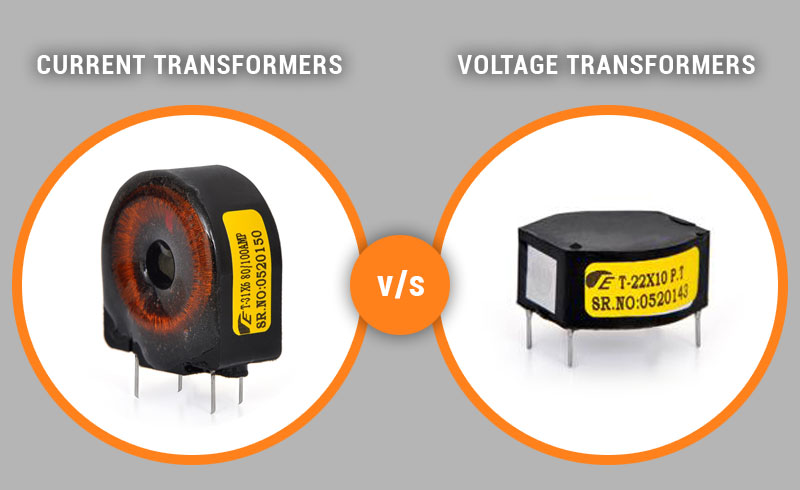No Product Added

By : Shah Electronics

In the world of electrical systems, transformers play a pivotal role. They facilitate the efficient transmission and measurement of electricity, making them indispensable in various applications. Let us talk about the two main types of transformers: Current Transformers (CTs) and Voltage Transformers (VTs), understanding more about their key differences, advantages, and disadvantages.
Transformers are electrical devices that transform voltage levels, allowing electricity to be transmitted over long distances and used in various applications. They consist of coils of wire wound around a core, which can be made of iron or other materials. Transformers come in various types and sizes, tailored to specific functions and voltage requirements.
There are primarily two types of transformers, each serving a unique purpose:
Current Transformers, commonly known as CTs, are designed to measure electric current. They play a crucial role in current measurement and protection systems. CTs are commonly used in electrical substations, industrial settings, and power distribution systems.
Voltage Transformers, also known as VTs or potential transformers, are engineered to measure voltage levels. They step down high voltage to a lower, measurable level suitable for instruments and meters. VTs find applications in voltage measurement, protection, and control systems, particularly in high-voltage environments.
Voltage Transformers, also known as VTs or potential transformers, are engineered to measure voltage levels. They step down high voltage to a lower, measurable level suitable for instruments and meters. VTs find applications in voltage measurement, protection, and control systems, particularly in high-voltage environments.
Understanding the key differences between CTs and VTs is crucial for selecting the right transformer for a particular application. Let's explore these differences in detail:
CTs are primarily designed to measure electric current. They provide a reduced, proportional current output, which allows for accurate current measurement and protection against overcurrent conditions. CTs are commonly used in applications such as metering, protection relays, and current monitoring systems.
VTs, also known as potential transformers, are engineered to measure voltage levels. They transform high voltage into a lower, more manageable voltage, suitable for instruments and meters. VTs are indispensable in voltage measurement, protection, and control systems, especially in high-voltage environments.
CTs are designed to handle high current levels. They are constructed with heavier conductors and are built to withstand the stresses associated with high-current flow.
VTs, on the other hand, are constructed with insulation materials and components that can withstand high voltage levels. They prioritize isolation and accurate voltage transformation.
CTs have a wide current measurement range, making them versatile for applications that require the monitoring of varying current levels.
VTs have a wide voltage measurement range, allowing them to accommodate high voltage levels and transform them into a suitable range for measurement.
CTs are commonly used in applications that involve current sensing and protection against overcurrent conditions. They are vital in metering electricity usage and safeguarding electrical systems from excessive current flow.
VTs are essential for voltage measurement and protection systems, particularly in high-voltage environments. They ensure that voltage levels are accurately monitored and controlled.
CTs are highly accurate when it comes to measuring current. They provide precise readings, which are critical for various applications, including billing and protection systems.
VTs also offer high accuracy when measuring voltage levels. Ensuring precise voltage measurements is essential in maintaining the stability and reliability of electrical systems.
Current Transformers (CTs) and Voltage Transformers (VTs) are essential components in electrical systems, each with its own set of advantages and disadvantages. Understanding these pros and cons is vital for selecting the right transformer for specific applications. Let uss talk about the strengths and limitations of both CTs and VTs:
CTs are renowned for their precision in measuring electric current. They offer highly accurate readings, ensuring that the current values are reliably and consistently monitored.
One of the primary roles of CTs is to provide effective overcurrent protection. They play a pivotal role in safeguarding electrical equipment and systems by detecting and responding to excessive current levels. This helps prevent damage, equipment failure, and electrical faults.
CTs have a wide current measurement range, making them versatile for various applications. Whether in low-current control circuits or high-current power distribution systems, CTs can be tailored to monitor different current levels effectively.
CTs find utility in a multitude of applications, ranging from energy metering and power quality monitoring to fault detection and protective relay systems.
VTs are highly regarded for their precision in measuring voltage levels. They deliver consistently accurate voltage readings, ensuring the reliability and stability of electrical systems.
VTs play a vital role in voltage protection systems. They are instrumental in accurately monitoring voltage levels and promptly responding to voltage abnormalities.
VTs are equipped with a broad voltage measurement range, allowing them to handle high voltage levels and transform them into a range suitable for measurement and monitoring.
VTs are well-suited for deployment in high-voltage environments, such as power substations, transmission lines, and industrial facilities with high-voltage equipment.
Both Current Transformers (CTs) and Voltage Transformers (VTs) play vital roles in electrical systems, albeit with different functions and characteristics. The choice between CTs and VTs depends on the specific requirements of the application. Shah Electronics stands as a reliable manufacturer of these transformers, offering high-quality solutions for the electrical industry in India. As you explore the world of transformers, remember that Shah Electronics is here to provide you with the best CTs and VTs tailored to your needs.
© 2025. Shah Electronics. All Rights Reserved. Terms of Use Privacy Policy Cookie Policy
Terms of Use
Privacy Policy
Cookie Policy
© 2025. Shah Electronics. All Rights Reserved.
Powered by WEBMANTRA